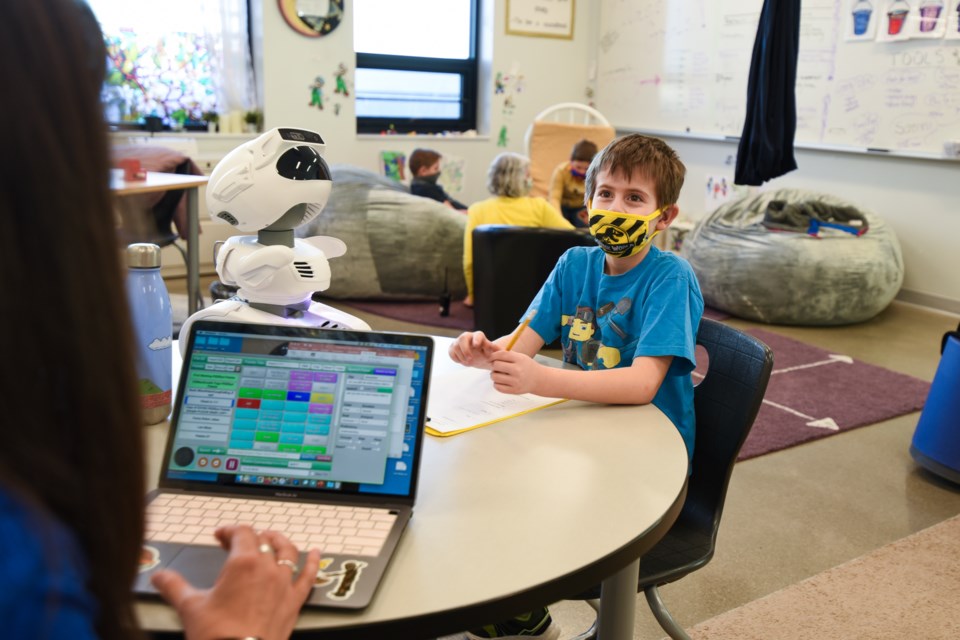The department of special education at St. Vrain Valley School District worked throughout the school year with the Innovation Center’s robotics program to help special needs students with social skills by using robots, according to a press release from SVVSD.
A project team of high school students developed Socially Assistive Robotics applications at the Innovation Center. In January, they partnered with teachers and staff at five district schools and used robots to support special education students with self-regulation, self-determination, and socialization, according to Mari Stevenson, SVVSD special education area coordinator.
The five schools participating in this collaboration are Longmont Estates Elementary, Eagle Crest Elementary, Indian Peaks Elementary, Longs Peak Middle School and Soaring Heights PK-8.
“It’s a collaboration and partnership between the Special Education Department, (special education) teachers, technology teachers, Innovation Center staff and (high school) student designers, all working as a team not only to build (the tools) but elevating the technology integration for all of our kids,” she said.
Since the beginning of the year, student designers have met twice a month to learn how to program the robots and determine what the robot will do and say as it interacts with staff and students, she said.
Teachers at the different schools worked together to come up with a plan for integrating the robots into the classroom setting, she said, adding the pilot program was introduced in one-on-one sessions with students.
“Settings are based on student IEP goals … to target skill areas to make a more significant impact,” she said. “Some of the students we are using this with are students who have not been responding much to human intervention and are actually responding to the robots.”
One student had minimal verbal language skills at the beginning of the term. After three sessions with the socially assistive robot, or Misty, and a teacher facilitator, the student was stringing full sentences together, Stevenson said.
“The student started three weeks ago and now he is actually communicating verbally and more intelligibly to other adults, whereas prior to these sessions, he was not,” Stevenson said. “This is just a pilot and we are already starting to see this (impact) and it’s pretty powerful.”
The program currently consists of four teams involving seven student designers, seven teachers and an SVVSD behavioral coach. Between ten and 15 students received support through the project, according to Stevenson.
The teams could grow to as many as 30 students as teachers learn how to use and implement the technology, she said. The technology could also benefit English language learners and be put to use by counselors and speech pathologists.
The use of robots with special education students, especially students on the autism spectrum, is a “game-changer” because they reduce the number of stimuli that can provoke sensory overload, according to Axel Reitzig, coordinator of innovation at the SVVSD Innovation Center.
“When interacting with people … the complexity of interactions can sometimes be too much, a robot simplifies that interaction and decreases the anxiety,” he said. “Also English language learners don’t feel like they are being judged, their emotional state is much more positive.”
The intended use of this kind of technology is not to replace anyone but simply to augment the impact of the work already happening, Reitzig said.
“The idea is to figure out what this technology can do better than we do and this frees us up to do what we do better than the technology,” he said. “We can double down our strengths as human beings by leveraging the power of these technologies to take things off our plate.”
SVVSD’s Innovation Center worked on Misty robots for the last eight years after the district turned its attention to artificial intelligence and robotics in 2014, Reitzig said.
This project is a way to explore the potential of technologies SVVSD and push that innovation throughout the district more broadly.
“Where could a Misty robot end up? Could it be a standard piece of equipment that could be found across the district in special ed programs, a counselor’s office or as a concierge service?” he said. “We are just scratching the surface.”
The teams will present their pilot program findings on May 17 to schools and partners during the Innovate to Elevate Exhibition Night at the Innovation Center from 4:30-5:30 p.m. The district will review the preliminary data and discuss how the program can be used across the district.
The main purpose of the exhibition is to get feedback from key stakeholders and have them ask the team hard questions, Reitzig said.
“We know this type of technology is an investment on the part of the district. We want to make sure we are intentional on how to make choices finding technology to support academic work,” Reitzig said.



.jpg;w=120;h=80;mode=crop)